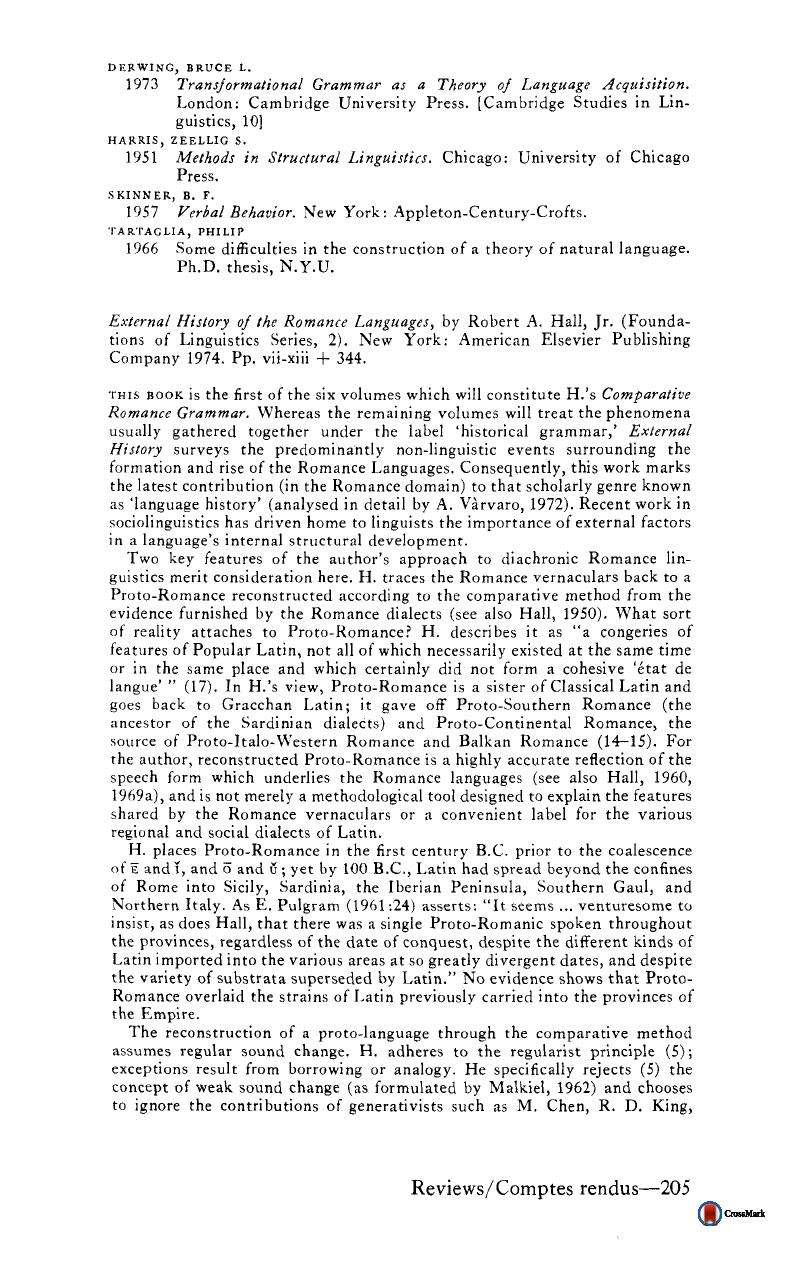No CrossRef data available.
Article contents
External History of the Romance Languages, by Robert A. HallJr . (Foundations of Linguistics Series, 2). New York: American Elsevier Publishing Company 1974. Pp. vii–xiii + 344.
Published online by Cambridge University Press: 27 June 2016
Abstract
An abstract is not available for this content so a preview has been provided. Please use the Get access link above for information on how to access this content.

- Type
- Reviews/Comptes rendus
- Information
- Canadian Journal of Linguistics/Revue canadienne de linguistique , Volume 22 , Issue 2 , Fall 1977 , pp. 205 - 209
- Copyright
- Copyright © Canadian Linguistic Association 1977
References
Alvar, Manuel
1968
Historia y lingüística: “colonización” franca en Aragón. Festschrift, Walther von Wartburg zum 80. Geburtstag, edited by Baldinger, Kurt Vol. 1. Tübingen: Niemeyer, pp. 129–50.Google Scholar
Baldinger, Kurt
1972
La formación de los dominios lingüísticos en la península ibérica. 2d ed. Madrid: Gredos.Google Scholar
Blaylock, Curtis
1968
Latin L-, -LL- in the Hispanic dialects: retroflexion and lenition. RPh
21. 392–409 (1967-68).Google Scholar
Butler, Johnathan
1971
Latin -īNUS, -īNA, -ĭNUS, and ĭNEUS:
from Proto-Indo-European to the Romance Languages. Berkeley, Los Angeles, and London: University of California Press. [University of California Publications in Linguistics 68].Google Scholar
Catalán, Diego
1971
En torno a la estructura silábica del español de ayer y del español de mañana. Sprache und Geschichte: Festschrift für Harri Meier zum 65. Geburtstag, edited by Coseriu, Eugenio and Stempel, Wolf-Dieter. Munich: Fink, pp. 77–110.Google Scholar
Corominas, Juan
1960
Sobre la etimología de
Madrid. RFE
43.447–50 [Reprinted in Corominas 1972.114–119].Google Scholar
Craddock, Jerry
1969
Latin legacy versus substratum residue: the unstressed “derivational” suffixes in the Romance vernaculars of the western Mediterranean. Berkeley and Los Angeles: University of California Press. [University of California Publications in Linguistics 53].Google Scholar
Hall, Robert A.
1950
The reconstruction of Proto-Romance. Lang. 26.6–27. [Reprinted in Joos, 1957.303–314].Google Scholar
Hall, Robert A.
1963
Idealism in Romance Linguistics. Ithaca: Cornell University Press.Google Scholar
Hall, Robert A.
1969a
Coerenza e realismo nella ricostruzione del protoromanzo. Lingua estile
4.399–404.Google Scholar
Hall, Robert A.
1969b
Some recent developments in American linguistics. Neuphilologische Mitteilungen
70.192–227.Google Scholar
Hall, Robert A.
1975
La non-lenizione nella Romània occidentale. RPh
28.530–5 (1974-75).Google Scholar
Izzo, Herbert
1972
Tuscan and Etruscan: the problem of substratum influence in central Italy. Toronto: University of Toronto Press.Google Scholar
Jungemann, Fredrick H.
1955
La teoría del sustrato y los dialectos hispano-romances y gascones. Madrid: Gredos.Google Scholar
Lapesa, Rafael
1950
La apócope de la vocal en castellano antiguo. Estudios dedicados a Menéndez Pidal, Vol. 2. Madrid: CSIC, pp. 185–226.Google Scholar
Malkiel, Yakov
1962
Weak phonetic change, spontaneous sound shift, lexical contamination. Lingua
11.263–275 [Reprinted in Malkiel 1968.33–45].Google Scholar
Malkiel, Yakov
1966
Form versus meaning in etymological analysis: Old Spanish
auze ‘luck.’ Estudios dedicados a James Homer Herriott. University of Wisconsin, pp. 167–183.Google Scholar
Malkiel, Yakov
1972
The rise of the nominal augments in Romance: Graeco-Latin and Tuscan clues to the prehistory of Hispano-Romance. RPh
26.306–34 (1972-73).Google Scholar
Malkiel, Yakov
1973 The pan-European suffix -esco, -esque in stratigraphic projection. Papers in linguistics and phonetics to the memory of Pierre Delattre, edited by Valdman, Albert. The Hague: Mouton, pp. 357–87.Google Scholar
Vàrvaro, Alberto
1972
Storia della lingua: passato e prospettive di una categoria controversa. RPh
26.16–51 and 509–31 (1972-73).Google Scholar
Walsh, John
1971
The Hispano-Oriental derivational suffix -í. RPh
25.159–72 (1971-72).Google Scholar


